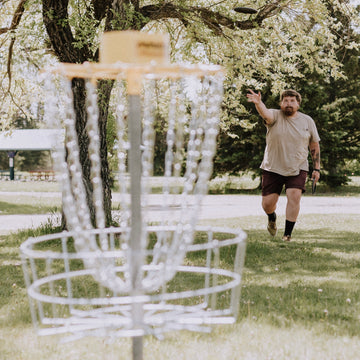How to Play Disc Golf:
Rules and Comparisons For Beginners
If you’re interested in learning how to play disc golf, you’ve come to the right place. While we don’t believe anything can top traditional golf, the many new variations to the sport make it easier for people of all skill levels to have fun together. Plus, it’s fun to mix up your hobbies every once in a while, right? Disc golf, also known as frisbee golf, combines the finesse of golf with the sheer joy of throwing frisbees. Read below for golf rules for beginners.

How to Play Frisbee Golf
The rules for disc golf ensure fair competition. Here are the fundamental frisbee golf rules you need to know:
- Objective: The goal in disc golf is to complete a course in as few throws as possible. Each hole consists of a designated tee area, a fairway, and a target called a "basket." Players aim to throw their discs from the tee and land them in the basket with the fewest throws.
- Tee Throws: The player initiating a hole performs the first throw from the tee area. Subsequent throws are made from the spot where the previous throw landed.
- Fairway Throws: After the tee throw, players progress through the fairway by throwing from the landing spot of their previous throw. The player farthest from the basket throws next.
- Marking Lie: When a player's disc comes to rest, they must mark the lie by placing a mini-marker disc directly in front of the disc. All subsequent throws must be taken from behind the lie.
- Out of Bounds: Frisbee golf courses often have designated areas considered out of bounds. If a throw lands outside the boundaries, a penalty stroke is added, and the player throws again from a designated drop zone or from the previous lie.
- Completion of Hole: The hole is completed when the disc lands in the basket. The player then moves to the next hole and repeats the process until the entire course is finished.

Disc Golf vs. Traditional Golf
While disc golf shares similarities with traditional golf, there are key differences that make it a unique and captivating sport:
- Equipment: Disc golf utilizes specialized frisbees or discs instead of clubs and balls. Discs vary in size, weight, and flight characteristics, catering to different throwing styles and distances. Similarly, traditional golf clubs have their own unique characteristics to maximize performance at different distances from the hole.
- Cost and Accessibility: Disc golf is relatively affordable compared to traditional golf. Public disc golf courses are abundant, and players only need a few discs to get started. The lack of greens fees and equipment expenses makes it accessible to a wider range of individuals.
- Physical Demands: While traditional golf can be a highly technical and challenging sport for children and beginners, frisbee golf is suitable for players of all ages and fitness levels.
- Strategic Elements: Disc golf, like traditional golf, requires careful planning and strategy to navigate the course effectively. Frisbee golf players must consider the terrain, wind conditions, and disc flight characteristics to choose the best throws. Likewise, traditional golfers must determine which club is most suitable for each swing.
- Community and Spirit: Both traditional golf and frisbee golf foster a sense of camaraderie and community among players. Due to its more casual nature, disc golf may provide a more comfortable community for beginners as it encourages inclusivity and supports players of all skill levels.

Disc golf, or frisbee golf, offers a thrilling and accessible alternative to traditional golf. The sport provides an immersive experience that combines skill, strategy, and a touch of adventure. Now that you know how to play disc golf, grab your discs and head to a local course with your friends!